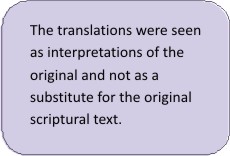Aid to comprehension
The translations of the Torah were seen more as guide books that helped in better unde rstanding the text, and not as the original text itself. The basic Hebrew text is believed to be sacrosanct and not open to emendations of any sort. Alpert notes that the inviolability of the text is “preserved by many rules of copying and checking as well as by the tradition of reading the Pentateuch publicly in Hebrew from a handwritten scroll” (270). This text, meant for public recitation is called the masoretic text and was standardized in the sixth or seventh century. It is considered to be the authentic original for all translations or interpretations. rstanding the text, and not as the original text itself. The basic Hebrew text is believed to be sacrosanct and not open to emendations of any sort. Alpert notes that the inviolability of the text is “preserved by many rules of copying and checking as well as by the tradition of reading the Pentateuch publicly in Hebrew from a handwritten scroll” (270). This text, meant for public recitation is called the masoretic text and was standardized in the sixth or seventh century. It is considered to be the authentic original for all translations or interpretations.
This means that the basic text was considered to be divine and singular, while the exegesis or interpretations were human and multiple. In fact, the Torah depended a lot on the interpretations of scholarly people during the Middle Ages, some of whom were Rashi, Ibn Ezra, Nachmanides etc. In fact, these commentaries were the part of later translations that were published in vernacular languages. Commentaries could range from clarifications of the basic text to scholarly studies that analyzed the text in greater detail and revealed hidden truths to the common reader.
|